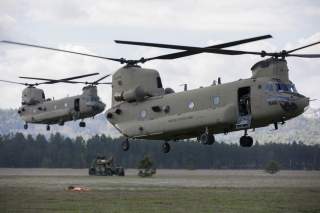Finland's Taistelukenttä Is The Best War Movie You've Never Seen
It captures the ferocity of hybrid warfare.
Key point: Modern war is far more multidomain, faster, and kinetic than war in the 1990s, and the trailer reflects that.
The pedagogical value of short films for military recruits is well known to the Finnish Defence Forces (FDF). In some units, every class sees some short films that are meant to prepare them in some way for their jobs as soldiers. One of the most prolific of these films is Taistelukenttä, or Battlefield, which has achieved near legendary status among those who served. But the original version of the film was produced in the 1990s, with the backdrop of the Yugoslav and Gulf wars. In order to prepare conscripts for potential conflicts in 2020 or further into the future, the FDF is commissioning an updated version of the film, the trailer for which dropped on January 13, 2020.
The trailer shows that the film is updated stylistically and thematically in how it presents the outbreak of war for Finland. In looking at the differences between the trailer and the original film, it may provide an interesting perspective into how warfare has changed in the last 30 years.
The original Taistelukenttä starts with shots of the beautiful Finnish wilderness and wildlife set to a 90s folk-rock ballad, then segues into footage of 1990s Finland: hockey victories, Helsinki beaches, farms. Presumably, the purpose of these shots is to remind the viewer of what they are defending. Of course, such shots probably seem incredibly nostalgic and quaint to contemporary viewers. As the song ends, the film cuts to shots of burnt buildings, interspersed with footage of an FDF soldier watching through the window of a car. After a couple of seconds of that, the exposition for the battle for Finland begins.
A news anchor announces that Finland and Sweden have increased defense cooperation, followed by announcements of the Netherlands, France, and Britain reinstituting the draft. Things seem to ramp up slowly, with Finland restricting access to its borders to only those with visas, NATO undertaking major military exercises in Germany, and the EU demanding Finland give military assistance to the Baltics. It’s important to note that the time frame here is in months: on the fake newspapers that are splashed onto the screen, the earliest is in October 1997. Things continue to ramp up, with preparations for general mobilization and reservists being called up to fight in April 1998. We see limited martial law provisions being implemented before the war, presumably due to some sabotage acts that occurred. Petrol and goods rations are imposed on the populace, media stations are brought under government control, and non-essential civilians are evacuated from the capital. Finally, things come to a head after a Finnish F/A-18 Hornet is shot down in the Gulf of Finland. This is a very slow, even Cold War-esque buildup to war. From the first headline to the last, there is a year of preparation, and a lot of time is given for the government to harden its facilities and draw up men.
In the Taistelukenttä 2020 trailer, the escalation seems to proceed at a far faster pace, mirroring situations like 2008 Georgia and 2014 Ukraine. The first shot in the trailer shows lights going out across Helsinki, presumably due to an act of sabotage or even a cyberattack. A FDF official is then heard narrating that Finland is being subjected to an aggressive influencing operation, presumably disinformation like that seen in Ukraine and Syria. After that, we see quick shots of the FDF mobilizing to defend the country.
Attacks happen rapidly after that. Missile attacks are prosecuted against FDF ships, and a civilian airliner is said to have an emergency which causes it to land at Kajaani airport. The trailer then shows a camera shot, presumably from the perspective of an airport fire truck, of armed men on the tarmac of the airport, advancing, accompanied by descriptions of military men. A news anchor then announces that a military operation is taking place at Kajaani airport, followed by shots of FDF Special Forces snipers and assaulters conducting operations there. This is probably indicative that Finland fears a “little green men” scenario, where unmarked or civilian marked vehicles and unmarked troops may be used to stage an attack on Finnish soil, and the film aims to show a resolute, decisive response. Only after the initial attacks does the Finnish parliament and president declare martial law and move Finland into an official state of war, as opposed to in the 1990s film where that occurred before the breakout of major hostilities.
In the trailer things only escalate from there, we see further shots of combat involving regulars and the Air Force and Navy. It’s important to note that the 1990s Taistelukenttä was not an optimistic propaganda film. Finnish troops are shown getting plastered at every turn, with enemy artillery pummeling an unprepared forward base, and mechanised troops going to the front dismounting in an enemy minefield of air or artillery scattered mines.
From the buildup to war seen in the trailer, it’s clear that Taistelukenttä has been thoroughly modernized for the modern era. Modern war is far more multidomain, faster, and kinetic than war in the 1990s, and the trailer reflects that. What we have yet to see is how the actual combat scenes in Taistelukenttä 2020 will pan out, but they probably will yield interesting insights into how near-future wars will be fought as well.
Charlie Gao studied political and computer science at Grinnell College and is a frequent commentator on defense and national security issues. This first appeared in January 2020.
Image: Reuters

